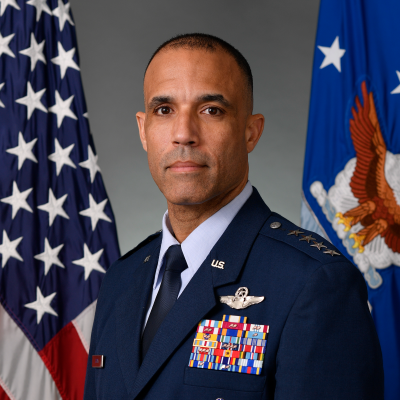Day Two | 5 November
7:20 - 8:25
REGISTRATION AND REFRESHMENTS
8:25 - 8:30
CHAIRMEN’S OPENING REMARKS
General (Ret'd) Frank Gorenc -
Former Commander,
USAFE-AFAFRICA
ACHIEVING FUTURE AIR DOMINANCE: PROGRAMME UPDATES
8:30 - 9:00
NEXT-GENERATION AIR DOMINANCE: ACHIEVING AIR DOMINANCE WITH THE F-47
Lieutenant General David Tabor -
Deputy Chief of Staff for Plans and Programs,
U.S. Air Force
• Updates from the Air Force program of the Future Years Defence Plan
• Progress of the Next Generation Air Dominance program with the award of the F-47 contract in 2025
• Addressing the challenge of interoperability across the USAF’s key capabilities
9:00 - 9:30
INDUSTRY INSIGHTS FROM EUROFIGHTER TYPHOON
9:30 - 10:00
GCAP AND FCAS UPDATE FROM THE UK
• Updates on Tempest development to improve air combat capabilities and address evolving threats
• Progress on GCAP negotiations and strategies to accelerate procurement
• Importance of collaboration for future fighter aircraft capabilities
10:30 - 11:00
FROM CONCEPT TO COMBAT: DELIVERING SOVEREIGN, SUSTAINABLE, LETHAL FIRES
Ryan Tseng -
Chief Strategy Officer and Co-Founder,
Shield AI
11:00 - 11:30
ADVANCING AIR COMBAT CAPABILITIES FOR THE US NAVY: MEETING TODAY’S AND TOMORROW’S THREATS
Vice Admiral Daniel Cheever -
Commander, Naval Air Forces,
US Navy
• Updates on the Navy’s NGAD program to achieve future air dominance
• Challenges of integrating legacy and future platforms to counter evolving peer threats
• Modernisation and upgrade programs for 4th and 5th generation platforms to enhance strike, reach, survivability, and networked operations
11:00 - 11:30
MORNING COFFEE AND NETWORKING
OPERATIONAL TRACK
12:00 - 12:30 INDUSTRY INSIGHTS FROM ANDURILOPERATIONAL TRACK
12:30 - 13:00 ACHIEVING AIR SUPERIORITY FROM INSIDE THE FORCE• Providing a tactical and strategic competitive advantage with cutting edge electromagnetic spectrum capabilities
• Operational, technical, and maintenance requirements for electromagnetic spectrum dominance
• Challenges of integrating EW systems for current and future fighter aircraft
OPERATIONAL TRACK
13:00 - 13:30 INDUSTRY INSIGHTS FROM NORTHROP GRUMMANADVANCED ENGINEERING & TECHNOLOGY TRACK
12:00 - 12:30 MODERNISATION AND CAPABILITY TRANSFER OF THE GERMAN FIGHTER FLEET• Ministry of Defence vision on maintaining and increasing combat effectiness
ADVANCED ENGINEERING & TECHNOLOGY TRACK
12:30 - 13:00 RESERVED FOR INDUSTRY INSIGHTSADVANCED ENGINEERING & TECHNOLOGY TRACK
13:00 - 13:30 FLIGHT-TESTED, FUTURE READY: ENGINEERING AIR DOMINANCE Colonel Lee Bryant - 96th Operations Group Commander, US Air Force• Understand how the 96th Operations Group is aligning strategies for air superiority with digital transformation
• Gain insights into the testing of manned and unmanned systems for future air operations
• Testing priorities and strategies for AI and other digital tools, and plans for successful integration
13:30 - 14:30
NETWORKING LUNCH BREAK
OPERATIONAL TRACK
14:30 - 15:00 UPCOMING REQUIREMENTS FOR THE US AIR FORCE TO SUPPORT FUTURE OPERATIONS Thomas 'Vulture' Lawhead - Assistant Deputy Chief of Staff, Strategy, Integration and Requirements, US Air Force• Upcoming requirements for an integrated Air Force
• Assessing the current operating environment to determine future requirements
• Delivering the right capabilities to the warfighter in a timely manner

Thomas 'Vulture' Lawhead
Assistant Deputy Chief of Staff, Strategy, Integration and RequirementsUS Air Force

OPERATIONAL TRACK
15:00 - 15:30 FRANCE’S FUTURE AIR COMBAT CAPABILITIES Major General Jean-Luc Moritz - FCAS Project Operational Chief, French Air and Space Force• Current French air combat capabilities and upcoming requirements
• Moving towards collaborative air warfare with allies
• Progress on the NGWS and the French Air and Space Force’s contribution
OPERATIONAL TRACK
15:30 - 16:00 PANEL DISCUSSION: INCREASING MAGAZINE DEPTH TO MAXIMISE THE NUMBER OF AIRCRAFT AVAILABLE FOR COMBAT• How can air forces and industry partners shift from lean inventories to scalable, resilient munitions stockpiles without compromising efficiency?
ADVANCED ENGINEERING & TECHNOLOGY TRACK
14:30 - 15:00 PANEL DISCUSSION: UNIQUE DEMANDS OF AIRCRAFT POWER AND PROPULSION• What are advancements needed in integrated propulsion, power, and thermal management to meet future fighter aircraft requirements?
• How can collaboration with industry better support future power requirements?
• What R&D initiatives are required to support advancements in aircraft power?
ADVANCED ENGINEERING & TECHNOLOGY TRACK
15:00 - 15:30 RESERVED FOR INDUSTRY INSIGHTSADVANCED ENGINEERING & TECHNOLOGY TRACK
15:30 - 16:00 BOLSTERING IN-FLIGHT DECISION MAKING WITH ADVANCED TECHNOLOGY Commander Jean Duboin - Navy Rafale Program Manager, French Navy• Current developments in the Navy Rafale Program
15:30 - 16:00
AFTERNOON TEA AND NETWORKING BREAK
16:30 - 17:00
KEYNOTE PRESENTATION: ENABLING AIR DOMINANCE FOR AIR COMBAT COMMAND
General Adrian Spain -
Commander,
Air Combat Command
17:00 - 17:30
PANEL DISCUSSION: ENABLERS OF AIR POWER - ELECTRONIC WARFARE, AEW, A2A REFUELING
Crista-lynn Ferguson -
Director General Fighter Capability,
Royal Canadian Air Force
David Nyikos - Director, International Business Development, L3Harris Technologies, Inc.
• What new EW and counter-countermeasure technologies are required to protect our network-centric warfare architecture while still enabling stand-off engagements?
• In an environment where the adversary can strike from beyond traditional engagement distances, how must our approach to enabling systems change?
• What are the central lessons we can extract from the recent May 2025 engagement regarding the evolution of long-range aerial threats?
• Given current long-range threat profiles, how critical is the role of AEW systems in detection and weapon guidance?
• To what extent did AEW and ISR capabilities redefine the rules of engagement and what improvements are needed for the future?
• What operational and logistical challenges are associated with extending fighter endurance in a high-threat, stand-off environment?
• In scenarios where rapid force projection is essential, how can we ensure that refueling operations themselves remain resilient to enemy detection and countermeasures?
• How can we refine our doctrine to maximise the synergy between stand-off detection, passive engagement, and rapid, precision retaliation?
• What do we need to understand about our adversaries’ EW capabilities and tactics to ensure spectrum dominance?
17:30 - 18:00
ACADEMIC INSIGHTS: CHALLENGES AND OPPORTUNITIES IN THE ROYAL AIR FORCE
Dr. Sophy Antrobus -
Research Fellow,
The Freeman Air and Space Institute, King's College London

Dr. Sophy Antrobus
Research FellowThe Freeman Air and Space Institute, King's College London























